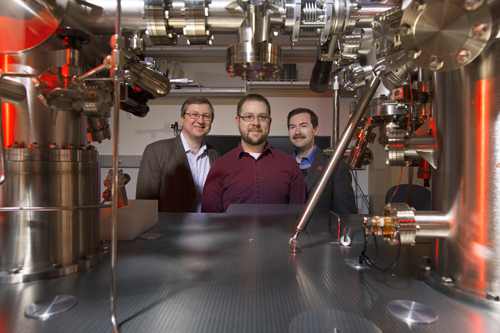
The ability to improve silicon transistors is reaching its fundamental limit, so researchers are searching for new ways to keep making electronic devices faster and more powerful. University of Nebraska-Lincoln physicists and colleagues have taken a major step toward breaking that silicon barrier.
UNL physicist Evgeny Tsymbal and colleagues demonstrated that a nanostructure with unique properties may hold the key to creating much smaller, more powerful electronics. They reported their findings in Nature Materials, published online this week. This work builds on predictions by Tsymbal, Bessey Professor of Physics and Astronomy and director of UNL's Materials Research Science and Engineering Center, and colleague John D. Burton, reported in Physical Review Letters in 2011.
They had theorized that a layer of ferroelectric oxide just a few atoms thick could be exploited as a memory element to store more digital information using less energy than silicon-based memories. Using quantum theories and super computers at the university's Holland Computing Center, they predicted how a ferroelectric memory element would behave.
Then they asked experimentalist Qi Li at Pennsylvania State University, UNL physicist Alexei Gruverman and colleagues at Oak Ridge National Laboratory, Tenn., and at universities in China and Korea to put their theories to the test. Those results proved the researchers' predictions correct.
The theory is based, in part, on a phenomenon called quantum tunneling, in which particles can pass through a barrier only at the quantum, or atomic, level. To develop a new generation of electronics, scientists are experimenting with tunnel junctions, in which an ultra-thin barrier is placed between two electrodes. When voltage is applied, electrons are able to tunnel through the barrier, creating a current with resistance.
Tsymbal and colleagues created a tunnel junction using nano-thin ferroelectric oxide, a material with both positive and negative polarization directions, which can be reversed by switching the voltage charge. They have shown that reversing the polarization changes the resistance through the tunnel junction by 100 times, a difference large enough to easily measure.
These ferroelectric properties are important because its two polarization directions could be read across regions like a binary code to store information. Tsymbal's team has shown that the measurable difference in resistance could be used to detect polarization directions.
Current silicon-based devices require large currents, so the size of the space between regions must be big enough to accommodate the heat that's generated. Because a ferroelectric device would use less energy, it would allow for more regions in a much smaller space, which would enable more compact and powerful devices.
Such a device won't hit stores anytime soon, however. The effect only works up to minus 100 degrees Fahrenheit.
"For applications, you obviously want to have this change in resistance at room temperature," Tsymbal said. "This can't be used immediately, but it shows some new directions to pursue."
Next, UNL's team will investigate other geometric and material configurations to find alternatives with greater applicability. Gruverman and Tsymbal also are exploring something called memristor. Rather than abruptly reversing polarization between two directions, memristor would allow changing polarization, and therefore resistance, continuously.
"Changing in a continuous way offers many stages of resistance and that will allow us to see more interesting physics and applications," Tsymbal said.
Co-authors are: UNL's Tysmbal, Burton and Gruverman; Li of Penn State; Y.W. Yin, Penn State and the Hefei National Laboratory for Physical Sciences at Microscale at the University of Science and Technology of China; X.G. Li, Hefei National Laboratory for Physical Sciences at Microscale at the University of Science and Technology of China; Y-M. Kim, Oak Ridge National Laboratory and Seoul National University, Korea; A.Y. Borisevich and S.J. Pennycook, Oak Ridge National Laboratory; and S.M. Yang and T.W. Noh, Seoul National University.
Grants from UNL's National Science Foundation-funded Materials Research Science and Engineering Center and the NSF's Nebraska Experimental Program to Stimulate Competitive Research help support this research.
-- Gillian Klucas